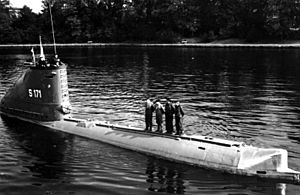German submarine U-2324 facts for kids

Postwar photo of Hecht (S 171), (former Type XXIII submarine U-2367). An identical sister ship of U-2324.
|
|
Quick facts for kids History |
|
|---|---|
| Name | U-2324 |
| Ordered | 20 September 1943 |
| Builder | Deutsche Werft, Hamburg |
| Yard number | 478 |
| Laid down | 21 April 1944 |
| Launched | 16 June 1944 |
| Commissioned | 25 July 1944 |
| Fate |
|
| General characteristics | |
| Class and type | Type XXIII submarine |
| Displacement |
|
| Length | 34.68 m (113 ft 9 in) |
| Beam | 3.02 m (9 ft 11 in) |
| Draft | 3.66 m (12 ft) |
| Propulsion |
|
| Speed |
|
| Range |
|
| Test depth | 180 m (590 ft) |
| Complement | 14–18 |
| Armament |
|
| Service record | |
| Part of: |
|
| Commanders: |
|
| Operations: |
|
| Victories: | None |
The German submarine U-2324 was a special type of submarine built for Nazi Germany during World War II. It was very advanced for its time! This submarine was one of the last ones to go on a mission during the war. It was also one of only three submarines of its kind to go on two missions. During these trips, it managed to sink one small British cargo ship. This was one of only five ships sunk by submarines of this type.
U-2324 was built in Hamburg in the spring of 1944. Because it was a new type of submarine with new technology, it needed a lot of testing and training. This helped the crew learn how to use its weapons best. So, it wasn't until January 1945 that its captain, Hans-Heinrich Haß, was allowed to take it on its first mission. This mission was off the eastern coast of Scotland.
Contents
Submarine Design and Features
The U-2324 was a Type XXIII submarine. These submarines were smaller than many others. When it was on the surface, it weighed about 234 tons. When it was underwater, it weighed about 258 tons.
Size and Dimensions
The submarine was about 34.68 meters (113 feet) long. Its widest part was about 3.02 meters (9 feet 11 inches) across. The part of the submarine that was underwater, called the draught, was about 3.66 meters (12 feet) deep.
Engines and Speed
The U-2324 had three different engines to help it move.
- It had one diesel engine for when it was on the surface. This engine gave it a lot of power.
- It also had two electric motors for when it was underwater. One of these was a powerful motor, and the other was a special quiet motor. This quiet motor helped it sneak around without being heard.
The submarine could travel at different speeds:
- On the surface, its top speed was about 9.7 knots (18 km/h or 11 mph).
- Underwater, it could go faster, up to 12.5 knots (23 km/h or 14 mph).
Travel Range
The U-2324 could travel long distances:
- When on the surface, it could go about 2,600 nautical miles (4,800 km or 3,000 mi) at a speed of 8 knots.
- When underwater, it could travel about 194 nautical miles (359 km or 223 mi) at a slower speed of 4 knots.
Depth and Crew
This submarine could dive very deep, up to 180 meters (590 feet). A small crew of 14 to 18 sailors worked on board. Unlike some larger submarines, the U-2324 did not have a deck gun.
Weapons
The U-2324 was armed with two torpedo tubes at the front. It could carry two torpedoes, which are underwater missiles used to attack enemy ships.
Submarine's Missions
The U-2324 went on two missions during the war.
First Mission
The first mission was not successful. The Allied forces had good ways to protect their ships and find submarines. This made it hard for U-2324 to find and attack any ships, even small ones. The submarine returned without sinking anything. After this, Captain Haß was replaced by Konstantin von Rappard, who became the new commander.
Second Mission and End of War
The second mission was also unsuccessful. U-2324 returned to Stavanger in Norway in May 1945, just one day before Germany surrendered.
When the war ended, U-2324 was in Norway. It then sailed to Loch Ryan in Scotland. This was part of an operation called Operation Deadlight. In this operation, many German submarines were sunk by the Allies so they couldn't be used again. On November 27, 1945, U-2324 was towed out to sea and destroyed. It was used as a target for naval gunnery practice.

